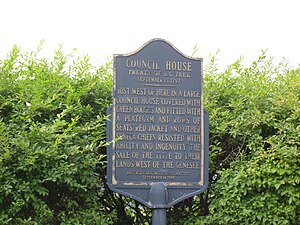 Modern-day marker describing the treaty on the campus of SUNY Geneseo | |
| Type | United States and Native American treaty |
|---|---|
| Signed | September 16, 1797 |
| Location | Genesee River in Seneca territory (in the present-day Town of Geneseo, New York) |
| Replaces | Treaty of Canandaigua |
| Replaced by | Second Treaty of Buffalo Creek |
| Parties | |
| Language | English |
The Treaty of Big Tree was a formal treaty signed in 1797 between the Seneca Nation and the United States, in which the Seneca relinquished their rights to nearly all of their traditional homeland in New York State—nearly 3.5 million acres.[1] In the 1788 Phelps and Gorham Purchase, the Haudenosaunee (Iroquois) had previously sold rights to their land between Seneca Lake and the Genesee River. The Treaty of Big Tree signed away their rights to all their territory west of the Genesee River except 12 small tracts[2] of land for $100,000 and other considerations (roughly $5 billion in 2020 dollars, in relation to GDP[3]). The money was not paid directly to the tribe, but was to be invested in shares of the Bank of the United States, and to be paid out to the Senecas in annual earnings of up to six percent, or $6,000 a year, on the bank stock.[4]
- ^ Conable, Barber. "Treaty of Big Tree 1797-1997". Genesee Country Magazine. No. Autumn/Holiday 1997. Retrieved July 30, 2017.
- ^ Smith, James H. (1881). The History of Livingston County, New York, 1687-1881. Syracuse, New York: D. Mason & Co. p. 76.
- ^ "What was a Dollar from the Past Worth Today?". MeasuringWorth. Retrieved April 17, 2020.
- ^ "Founders Online: Editorial Note: Memorandum on the Seneca Annuity". founders.archives.gov. Retrieved 2020-04-18.